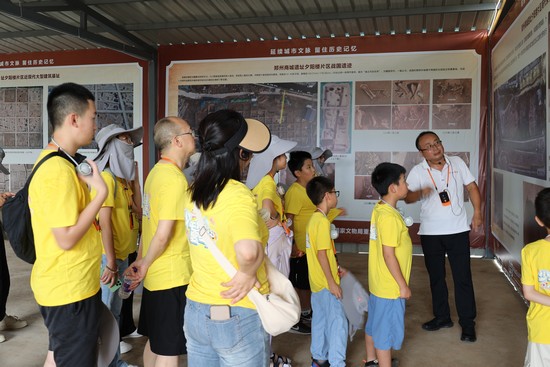“We are Little Archaeologists” —— A Story of the Study Tour in the Xiyanglou Area of Zhengzhou Shang Dynasty Ruins in Zhengzhou
Date Posted: 2024-08-09


In recent years, the "archaeology fever" has sparked the enthusiasm of more and more people for archaeology, and its popularity has continued to grow. More and more citizens are showing their interest in archaeology by taking tours of ancient remains and relics, entering archaeological sites and visiting excavation sites, which has become a practical demand for people's interest and understanding of archaeology. During the summer holidays, many activities were carried out, such as the study tours of historical remains and relics and the public open days at archaeological sites, linking archaeology with people's lives.
On August 5, a study tour of more than 20 students visited the Xiyanglou area of the Capital Site of Shang Dynasty in Guancheng District, Zhengzhou City, Henan Province. Under the guidance of Yang Shu'gang, director of the Zhengzhou Workstation of the Henan Provincial Institute of Cultural Heritage and Archaeology, they enjoyed a tour of the excavation sites, which allowed them to understand the history and rich cultural accumulation of the Capital Site of Shang Dynasty in Zhengzhou. Through the tour and interaction, the students understood the excavation process and were impressed by the experience, which could not be found in textbooks, which deeply aroused their curiosity about archaeology.


Activities at the Archaeological Site
“The Xiyanglou Area of Zhengzhou Shang Dynasty Ruins is an excavating site of the capital of the early Shang Dynasty, which is also considered the first capital of the Shang Dynasty. A large number of relics from the Shang Dynasty have been unearthed here, identifying the missing puzzles for the Shang Culture before the Yin Ruins Culture. This area is known as an essential support and factual carrier for the exploration of Chinese civilization, which is not only the “root” and “soul” of Zhengzhou City, but also a treasure in the history of the ancient civilization of China and even the world,” Yang Shu’gang said.
Over 20 Students Visiting the Archaeological Site and the City Wall in Zhengzhou Shang Dynasty Ruins.


Director Yang Shu’gang Explaining the Knowledge of the Shang Dynasty Ruins to Students
To promote the sound development of the global museum cause and to attract the public’s understanding, participation, and concern for museums from the whole society, in 1977, the International Council of Museums (ICOM) proclaimed May 18, 1997, as the first International Museum Day. Since then, ICOM has designated a theme for this day every year.
A series of interactive activities, including explaining the exhibition boards, walking the trestle, and ascending the city wall, facilitated the students learning about the excavation of Shang Dynasty Ruins in the Xiyanglou Area, understanding the daily work of the frontline archaeologists and the significance of protecting cultural heritage. The activities made them gain new knowledge and understanding of our archaeological work and Chinese traditional culture.


The Site Manager, Zhang Dai, Explaining Archaeological Knowledge to the Students.
At the archaeological scene, Zhang Dai, the site manager of the Xiyanglou Area, gave students a detailed explanation of the process of site investigation and excavation, as well as various tools used. The students were acting as “little archaeologists”, personally handling the professional tools.
Archaeological study tours offer a distinctive educational opportunity. For students who participate in archaeological study tours, especially those with an existing interest in archaeology, visiting archaeological sites can facilitate not only a deeper understanding of archaeological excavations but also the development of practical abilities. “We participated in an archaeological study tour from Beijing with our kid. Prior to our visit to Zhengzhou, we had limited knowledge of the city, only aware that it is the capital of Henan Province. We were unaware of the reasons why it is one of the Eight Great Ancient Capitals. After visiting the site, I observed a vast array of artifacts unearthed from the Zhengzhou Shang Dynasty Ruins, which fostered a sense of engagement with history spanning thousands of years. Participating in the study tour with my children not only deepened my understanding of Zhengzhou but also enhanced my knowledge of the cultural heritage of the Zhengzhou Shang Dynasty Ruins. I firmly believe that this trip was a valuable experience”, one of the students’ parent said.
This study tour offered students a direct, face-to-face encounter with historical sites and cultural relics. This hands-on experience far surpasses the written description in the classroom. It is believed that students will be able to gain a deeper understanding of history and culture, increasing their awareness and respect for ancient civilizations. At the same time, students personally participate in archaeological excavations, which greatly stimulates their enthusiasm for history, archaeology and cultural heritage protection. It also has an irreplaceable significance in cultivating students' understanding of history and culture, cultivating their practical ability, stimulating their interest in learning, promoting interdisciplinary learning, and enhancing their awareness of cultural heritage protection.







